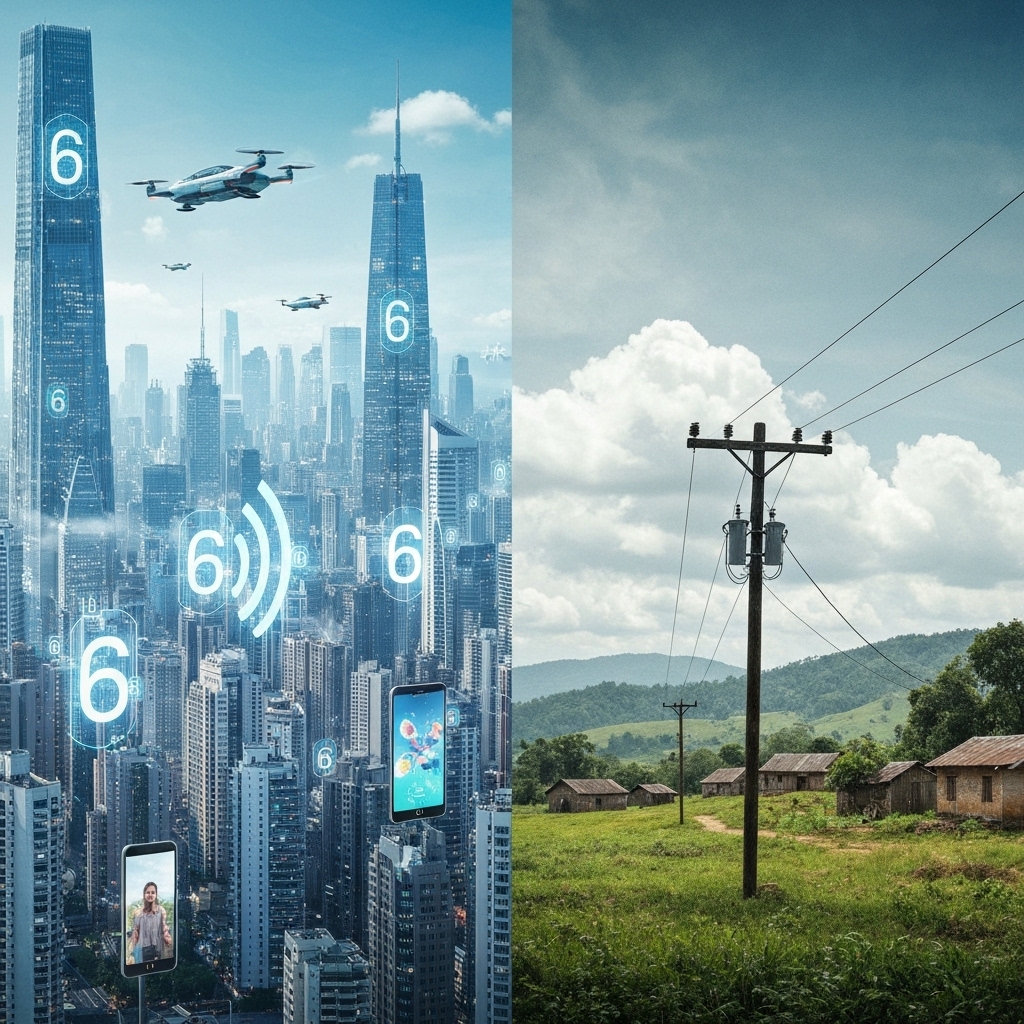The rollout of 6G networks marks a pivotal moment in the evolution of wireless communication, pushing the boundaries of what’s possible with mobile connectivity. While still in its early deployment phases, 6G is expected to deliver data speeds up to 1 terabit per second—orders of magnitude faster than current 5G capabilities. This leap isn’t just about quicker downloads; it enables real-time interactions with minimal latency, making applications like remote surgery and autonomous vehicle coordination far more reliable. Experts at institutions like the International Telecommunication Union (ITU) are already defining the global standards that will shape this next-generation network.
One of the most exciting aspects of 6G is its potential to seamlessly integrate with emerging technologies such as augmented reality (AR), virtual reality (VR), and artificial intelligence (AI). Imagine walking through a city with AR glasses that instantly overlay navigation, language translation, and historical facts—all without lag. These experiences rely on ultra-reliable, high-bandwidth connections that 6G is designed to provide. Companies like Samsung and Nokia are investing heavily in research, with Samsung outlining their 6G vision in a detailed white paper available through their technology insights portal.
Beyond consumer applications, 6G could revolutionize industries by enabling massive machine-type communications and ultra-precise synchronization across devices. Smart factories, intelligent transportation systems, and next-gen smart cities will benefit from the network’s ability to connect millions of devices per square kilometer with near-zero delay. According to the National Institute of Standards and Technology (NIST), these advancements will require new approaches to spectrum utilization, including the use of terahertz frequencies, which bring both opportunities and technical challenges.
While widespread 6G adoption is likely still several years away, the foundational work happening now sets the stage for a deeply interconnected future. Unlike previous generational shifts, 6G is being developed with sustainability and energy efficiency in mind, aiming to reduce the environmental footprint of digital infrastructure. As research continues and pilot programs expand, users can expect a gradual transition that builds on the strengths of 5G while unlocking entirely new possibilities in how we live, work, and communicate.
What Is 6G and How Does It Work?
6G, the next frontier in wireless communication, is set to revolutionize how we connect by operating in the terahertz (THz) frequency band. This leap from 5G’s millimeter-wave spectrum allows for data transmission speeds reaching up to 1 terabit per second—fast enough to download hundreds of high-definition movies in seconds. Such blistering speeds could enable transformative applications in augmented reality, autonomous systems, and real-time remote surgery. According to the International Telecommunication Union (ITU), these advancements will form the backbone of future smart societies.
To achieve this level of performance, 6G integrates cutting-edge technologies like AI-optimized network routing, which dynamically adjusts data pathways based on traffic, device density, and environmental conditions. This intelligent adaptation ensures consistent connectivity and ultra-low latency, even in highly congested areas. Holographic beamforming further enhances signal precision by shaping electromagnetic waves into focused, reconfigurable beams that can follow users seamlessly across spaces. These innovations are being explored by leading research institutions such as the Nokia Bell Labs and supported by global academic consortia.
Another cornerstone of 6G infrastructure is the deployment of ultra-dense small cell networks, consisting of numerous low-power base stations placed in close proximity. This design improves coverage and capacity, particularly in urban environments where signal blockage and interference are common. By distributing network load more efficiently, these cells help maintain reliability across diverse use cases—from connected vehicles to industrial IoT. The IEEE has been actively publishing standards and research to guide the responsible development of such dense network topologies.
While still in its research and development phase, with commercial rollout expected around 2030, 6G promises to bridge the digital divide and unlock new dimensions in human-machine interaction. Countries like Finland, South Korea, and the United States have already launched national initiatives to accelerate 6G innovation. As the technology evolves, collaboration between governments, academia, and industry will be crucial to address challenges related to energy efficiency, security, and spectrum allocation. For ongoing updates, organizations like the Next G Alliance are coordinating efforts to shape a unified 6G roadmap.

Revolutionizing Mobile Experiences
Imagine downloading an entire 8K movie in just seconds—no more waiting, no more buffering. With the rollout of 6G technology on the horizon, this kind of speed could soon become everyday reality. Building on the foundation laid by 5G, 6G aims to deliver data rates up to 1 terabit per second, enabling near-instantaneous downloads and ultra-smooth streaming experiences. This leap in performance will transform how we consume media, making high-resolution content accessible in real time across mobile networks. For more on the technical roadmap, the International Telecommunication Union (ITU) is leading global standardization efforts.
Beyond faster downloads, 6G will unlock immersive experiences like volumetric video streaming and lag-free cloud gaming. These applications require not just speed, but incredibly low latency and massive network reliability—precisely what 6G promises. Gamers could experience fully interactive, photorealistic virtual worlds with zero input delay, while remote collaboration might evolve into shared 3D environments that feel physically present. Such advancements rely on edge computing and AI-driven network optimization, technologies being explored by institutions like Nokia Bell Labs and other industry pioneers.
Perhaps most revolutionary is how 6G could extend mobile interaction beyond screens. Early trials are already exploring real-time haptic feedback, allowing users to “feel” digital objects through their devices. Even more futuristic, research into brain-computer interfaces (BCIs) may enable direct neural control of mobile applications, offering intuitive, hands-free interaction. While still in experimental stages, projects funded by organizations like the Defense Advanced Research Projects Agency (DARPA) are paving the way for these breakthroughs.
Transforming Industries and Smart Infrastructure
As 6G networks roll out, their impact will stretch far beyond faster smartphones, transforming entire cities into responsive, interconnected ecosystems. With near-zero latency and ultra-high bandwidth, 6G will allow traffic lights to communicate with vehicles in real time, optimizing flow and reducing congestion. Energy grids could dynamically adjust power distribution based on real-time demand, improving efficiency and supporting renewable integration. Public safety systems might leverage instant data sharing between surveillance, emergency services, and infrastructure to respond more effectively to incidents. These advancements are paving the way for truly adaptive urban environments—learn more about smart city technologies at IEEE.
In healthcare, 6G is poised to revolutionize how medical services are delivered, particularly in underserved or remote regions. Surgeons could operate robotic arms from thousands of miles away using haptic feedback and real-time high-definition imaging, making complex procedures accessible regardless of a patient’s location. This level of precision demands the reliability and speed only 6G can provide, minimizing delays that could risk patient safety. Telemedicine would evolve from video calls to immersive, interactive experiences powered by augmented reality and instant data processing. For insights into the future of telehealth and robotics, visit Nature.

Privacy, Security, and Accessibility Challenges
The unprecedented data speeds and connectivity density of 6G networks will revolutionize how we interact with technology, but they also introduce significant privacy challenges. With the potential to connect billions of devices—from smart home appliances to autonomous vehicles—the sheer volume of personal data being transmitted will make user privacy a top concern. Each connected device becomes a potential entry point for malicious actors, making robust encryption and real-time threat detection essential. Organizations like the National Institute of Standards and Technology (NIST) are already working on post-quantum cryptography standards that could help safeguard data in this new era.
Securing endpoints is no longer just about protecting individual devices—it’s about ensuring trust across entire ecosystems. As 6G enables more seamless machine-to-machine communication, managing user consent for data collection and sharing will require transparent, automated systems. Technologies like decentralized identity and blockchain-based authorization frameworks may play a key role in giving users control over their digital footprints. The IEEE has been actively developing ethical guidelines for next-generation networks to ensure these systems respect user autonomy and data sovereignty.
Beyond security, the rollout of 6G must address the risk of deepening the digital divide. Without deliberate policy and infrastructure investment, rural and underserved communities could be left behind as urban centers reap the benefits of ultra-fast connectivity. Ensuring equitable access means not only expanding physical network coverage but also making services affordable and digital literacy widespread. Initiatives like the International Telecommunication Union (ITU)‘s Connect 2030 Agenda emphasize inclusive growth as a cornerstone of future telecommunications development.
Ultimately, the success of 6G won’t be measured just by speed or latency, but by how fairly and safely it serves everyone. Policymakers, technologists, and civil society must collaborate early to embed privacy, security, and equity into the foundation of next-generation networks. Proactive regulation and international cooperation will be crucial in shaping a 6G future that’s both innovative and just.

Conclusion: A Hyperconnected Future Within Reach
6G networks are set to redefine how we interact with technology, pushing the boundaries of speed and connectivity far beyond what’s possible today. With theoretical speeds reaching up to 1 terabit per second, 6G could make current 5G capabilities seem sluggish in comparison. This leap isn’t just about faster downloads—it’s about enabling near-instantaneous communication between devices, supporting advanced applications like holographic telepresence and real-time AI processing. Experts anticipate that 6G will integrate seamlessly with edge computing and artificial intelligence, creating smarter, more responsive digital environments. For more on the technical roadmap, the International Telecommunication Union (ITU) is leading global standardization efforts.
One of the most transformative aspects of 6G will be its ability to support mission-critical applications in healthcare, transportation, and urban infrastructure. Imagine remote surgeries conducted with zero latency or autonomous vehicles navigating complex cityscapes with flawless coordination—these scenarios become feasible with 6G’s ultra-reliable, low-latency connections. The network’s enhanced sensing capabilities may even allow devices to « see » and interpret their surroundings, blurring the line between physical and digital perception. Research institutions like the Nokia Bell Labs are already exploring how these features can revolutionize everyday life.
Despite its promise, deploying 6G comes with significant challenges, from developing new spectrum bands to ensuring energy-efficient infrastructure. Regulatory frameworks and international cooperation will play a crucial role in shaping a secure and accessible rollout. As with any emerging technology, equitable access will be vital to prevent deepening the digital divide. Staying informed through trusted sources like the Institute of Electrical and Electronics Engineers (IEEE) can help users and policymakers understand the evolving landscape.
For everyday users, the shift to 6G will mean richer, more immersive digital experiences—from hyper-realistic virtual reality to intelligent personal assistants that anticipate needs with uncanny accuracy. As global trials begin in the early 2030s, adaptability will be key for individuals and industries alike. Embracing this next wave of connectivity won’t just be about upgrading devices; it will require a mindset open to continuous innovation and lifelong learning in an increasingly interconnected world.
